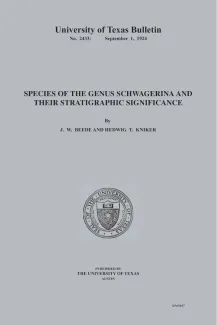Publication Details
Get the Publication
Abstract/Description:
Species of the genus Schwagerina occur in most of the outcropping limestones formed in the open, connected, epicontinental seas existing at the time of the initiation of the Permian fauna and flora.
They are highly organized foraminifera, of large size, and they occupy a limited thickness of rocks. They thus form valuable horizon-markers wherever they occur.
The Schwagerina were differentiated from Fusulina in a definite horizon in America and Europe, and existed for longer or shorter periods, depending upon the stability of conditions in any particular region. This differentiation of the simpler forms of Fusulina into Schwagerina in one line; into Doliolina, followed by Neoschwagerina and Sumatrina in another line; and the giant Fusulina as a continuation of the main stem of the genus, is symbolic of changes initiated contemporaneously in the Brachiopoda, Pelecypoda, Ammonoidea, Vertebrata, plants and other forms of life which came later to characterize the fauna and flora of the Permian period.
